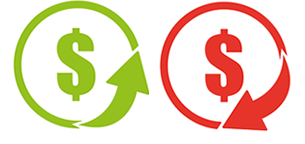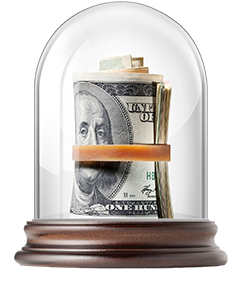How to tell the difference
 Not all debt is created equal. Knowing the difference can change the way you look at your spending.
Not all debt is created equal. Knowing the difference can change the way you look at your spending.
Good debt adds value
Good debt often leads to financial growth, because the product or service being purchased adds more value than the debt that comes with it. Student loans are usually an example of good debt because the related education allows you to earn more income.
Some purchases result in value more directly. Taking on a mortgage, for example, can be valuable simply by giving you access to a place to live all while building equity. Additionally, a mortgage is often considered good debt because your property can be used as collateral for other debt once you’ve made some payments on it, or your home has gained in market value. Even better, good debt often comes with a tax deduction on the interest you pay on things like your mortgage or student loans.
Bad debt adds expense
Credit card debt is almost always bad debt. Not only are interest rates on credit cards higher than most other types of debt, but most purchases made with credit cards are for things that do not contribute to personal financial growth. In fact, interest expense is so high that credit card companies are now legally required to display the cost of this debt directly on their billing statements. Auto loans are another example of bad debt, because cars usually lose value quickly, often leaving more money owed on the debt than the car is worth! But even good debt can turn bad if there is too much of it. Take out too large a mortgage and you may struggle to make payments!
Debt always means higher cost
Debt’s big benefit is allowing you to pay for something over time. The cost of any purchase using debt MUST include the interest expense of taking on that debt. You can compare that with the option of saving up money and then making the purchase without interest. Is the extra interest worth the benefit? Comparing the cost of the purchase with interest, to the value you stand to gain by purchasing the asset, can help you determine whether using debt is a good or bad choice for you.
Final thoughts
Here are some ideas on how to manage good versus bad debt.
- Consider carefully what you can afford and make a plan for how you will pay off any debts before you take on the debt.
- Never carry a balance on a credit card unless it is an emergency. Pay the balance in full every month.
- Calculate the entire cost, including interest, of anything you purchase using debt. This is the REAL cost of an item.
- Use savings, whenever possible, to purchase goods and services that would otherwise be considered bad debt.
- Pay off high interest debt first.
- Financial growth is often the key measure for defining good versus bad debt, but not always. Other factors, like personal interest, growth, and well-being can also be measures for your debt decisions, as long as you can truly afford the payments.
Reach out for help if you aren’t confident whether a potential debt will be beneficial or harmful. Making the right choice could save you money.
 As a small business, once you decide to extend credit to a customer, you now have a financial stake in continuing that relationship even if you suspect there might be trouble brewing. While you don’t want to crack down on a good customer too hard, too soon, you also don’t want to be taken advantage of by a customer who has become unable or unwilling to pay. Here are some ideas to help you manage this risk.
As a small business, once you decide to extend credit to a customer, you now have a financial stake in continuing that relationship even if you suspect there might be trouble brewing. While you don’t want to crack down on a good customer too hard, too soon, you also don’t want to be taken advantage of by a customer who has become unable or unwilling to pay. Here are some ideas to help you manage this risk.
Develop a rating system. Score each customer with a number. The number represents to whom you will sell on credit and how much risk you are willing to take. Also have scores that represent customers you will not bill and those who you will no longer take orders from because of credit risk. Develop a system to objectively assign the score. Payment history and external credit scoring reports are both good indicators of whether a particular customer will be an acceptable credit risk.
Consider credit applications. Create a simple credit application. The application should be signed by the responsible party to pay the bill. If large credit amounts are expected, get a person to take personal responsibility to pay the bill. This will provide an additional means to collect your money should the company fail to pay. You will need this signed document if you wish to use a collection agency to collect delinquent accounts.
Look at history. Those to whom you provide a credit line must have their payment history monitored. If they are habitually late payers, reduce their credit line. If they frequently miss payments, move them to prepay only.
Create a notes section on your customer records. Use this to record what a late paying customer tells you. Over time, this will reveal the customers who are honest and the customers who fail that test. This idea also provides continuity of communication for the customer that tries to tell different employees different stories.
Develop a collection system. The best credit rating system starts with a receivable aging report run once a month. This will quickly show you current trouble customers and potential trouble customers. When a bill ages through the report, know what you are going to do to collect bills at 30 days, 60 days, 90 days and anything older than that.
Look for other signs of trouble. Train your team to be on alert for:
- Customers paying smaller invoices while larger invoices go unpaid.
- The customer fails to return your phone calls or shows annoyance at your inquiries.
- Your requests for information, such as updated financial statements, are ignored.
- The customer places multiple, large orders and presses you for a higher credit limit.
- The customer tries to coax you into providing a good credit report to another supplier.
- You get word that the customer’s credit rating has been downgraded.
Remember, great customers can have sincere problems paying a bill. By having a good credit rating system, you can more readily identify the customers you want to accommodate to pay their bills and those customers whose activity should be suspended because they are truly problem accounts.
Which unique method of budgeting will work for you?
 You have your own unique personality, preferences and lifestyle. Likewise, how you manage and organize your finances can have its own personality, including how you budget. Here are five different methods of budgeting, each with a distinct way of helping you organize your spending and finances.
You have your own unique personality, preferences and lifestyle. Likewise, how you manage and organize your finances can have its own personality, including how you budget. Here are five different methods of budgeting, each with a distinct way of helping you organize your spending and finances.
- Traditional budget. Use last year’s budget as a base, make any necessary adjustments due to changes in your income or expenses, and create your budget by taking your income minus your expenses to equal the amount you have to spend.
- Envelope budget. Keep a set amount of cash for the month in envelopes labeled with an expense category like groceries, clothing, eating out, entertainment, etc. Use one envelope per expense category. If you run out of money in one envelope, you can dip into other envelopes, but this will obviously impact spending in those areas.
- Reverse budget. Instead of stashing away the money left over after you’re done spending for the month, first take out your portion for savings and then spend the amount of money that remains. Reverse budgeting is an effective way to prioritize saving for your future retirement, an emergency or rainy-day fund, or other big expenses like a vacation, a new car, or a down payment on a house.
- Zero-based budget. Know where each dollar is going and record every single dollar spent. Also called the zero-sum or down-to-the-dollar budget, this method helps you get specific about spending and keeping track of all your dollars. Instead of one amount allotted for food, you know exactly how much you will spend on groceries, lunch while at work, and dining out. Instead of one amount allotted for savings, you know exactly how much you are putting into retirement, loan repayment, and emergency savings.
- 50/20/30 budget. Stick to three spending categories. Each month, 50% of your take-home income goes toward needs, 20% toward savings, and 30% toward wants. Examples of needs are housing or car payments and groceries. Savings could be retirement money, paying off loans, and emergency funds. Wants include things like shopping, vacation, or entertainment. Less detailed than the zero-based or envelope methods but more detailed than traditional or reverse budgeting, the 50/20/30 method helps you monitor money habits by helping you stick to three categories every month.
The best budget approach? One that works for you and one that you will continue to use. So pick an approach and try it. It can really change how you spend your money.
As always, should you have any questions or concerns regarding your tax situation please feel free to call.
 As the end of the year approaches, there is still time to make moves to manage your tax liability. Here are some ideas to consider.
As the end of the year approaches, there is still time to make moves to manage your tax liability. Here are some ideas to consider.
Maximize your retirement plan contributions. This includes traditional IRAs, Roth IRAs, and SEP IRAs for self-employed. Now is the time to maximize the contribution potential for this year and plan for next year’s contributions.
Estimate your current and next year taxable income. With this estimate you can determine which year receives the greatest benefit from a reduction in income. By understanding what the tax rate will be for your next dollar earned, you can understand the tax benefit of reducing income in this year versus next year.
Make charitable contributions. Consider which tax year will benefit most from your charitable giving of cash and non-cash items. Shift your giving into the year that will provide you the most benefit.
Take capital losses. Each year you can net capital losses against capital gains. You can also deduct up to $3,000 in excess losses against your other income. Start to identify which investments may make sense to sell to take advantage of this. If planned correctly, these losses can offset ordinary income.
Consider donating appreciated stock. This strategy gives you a charitable deduction for the market value of the stock, while not having to pay capital gains tax on the charitable gift. If you provide an annual pledge sheet to your church, this can be a great way to maximize your gift while giving needed funds to your church at the beginning of the year.
Retirement plan distributions. If you are age 70½ or older, take your required minimum distributions for the year. If you are retired, but younger than 70½, consider taking tax efficient distributions from your retirement accounts. By paying some tax now, you may avoid paying higher taxes later when you have to follow the minimum distribution rules.
Consider tax legislation. Please recall that tax laws passed in late 2016 made many temporary tax savings permanent and extended others into 2017. So save classroom related receipts if you are a teacher. Consider charitable contributions from your retirement plan if you are a senior. Keep receipts of large purchases to track a potential sales tax deduction.